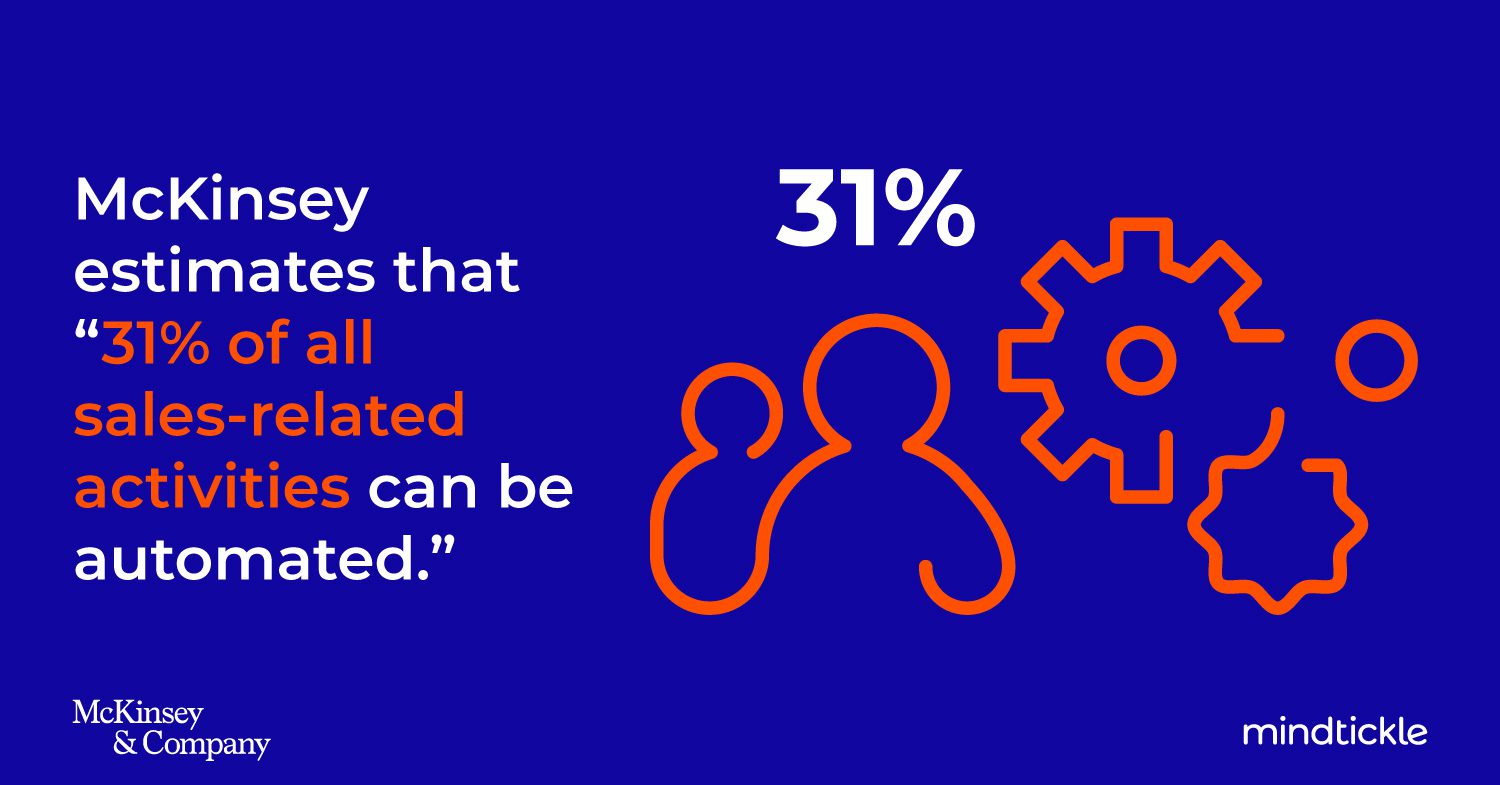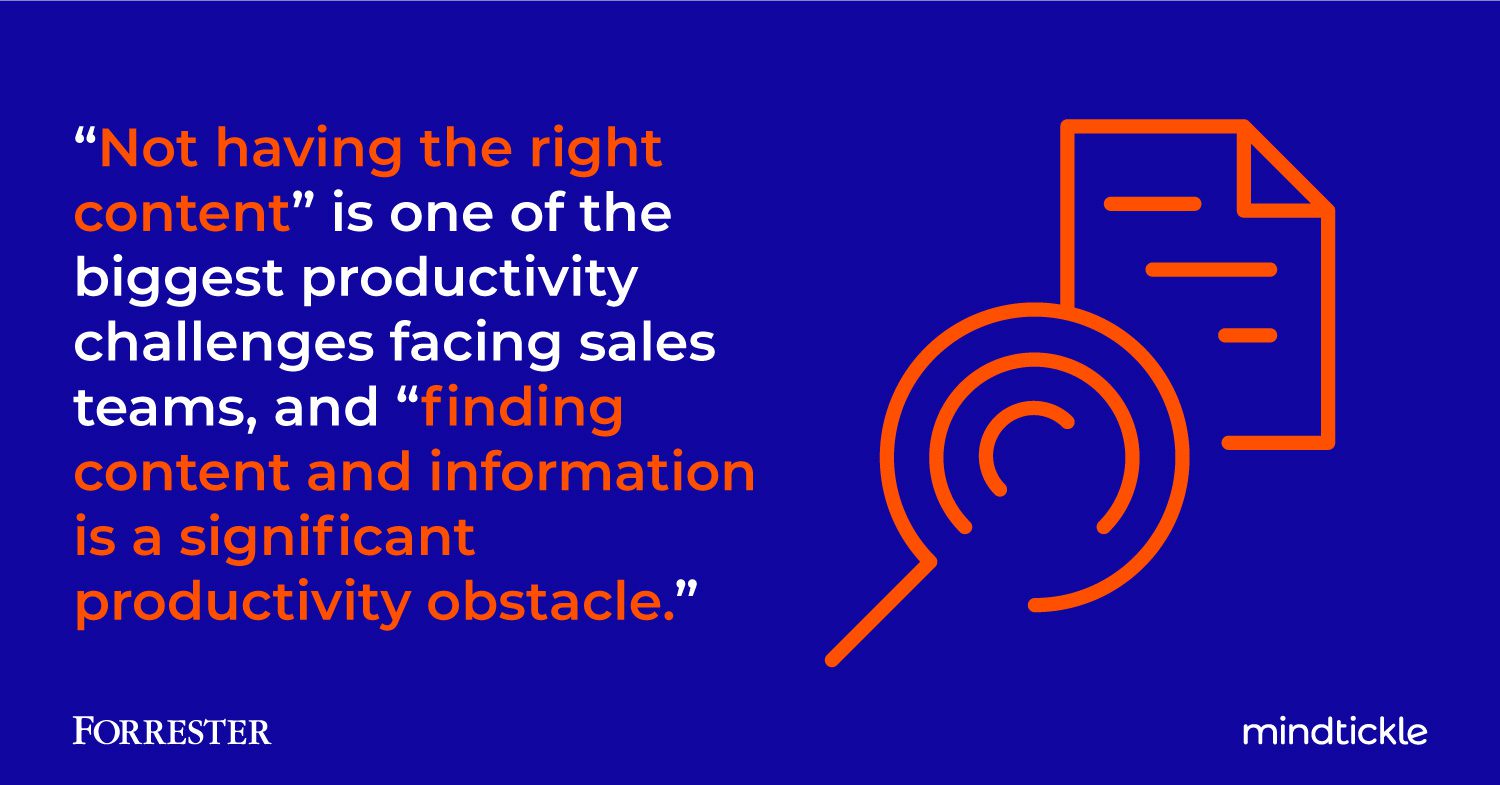Today, sales reps spend only 23% of their time on core sales activities and direct engagement with buyers. They spend an increasing amount of time on administrative chores like entering data into a growing number of disconnected sales tools. As a result, sellers are frustrated by the growing number of tasks that get in the way of their main job: selling.
To improve sales productivity, you need to focus on removing the roadblocks eating up your team’s time so reps can prioritize revenue-generating activities. Even a small uplift in the amount of time each rep spends on core selling activities will add up to a big productivity boost across your entire sales team. Here are four practical ways you can help your sales team dedicate more time to closing deals and driving revenue for your business.
1. Automate data entry
McKinsey estimates that “31% of all sales-related activities can be automated” to improve your team’s productivity levels. Data entry is a perfect candidate for automation because putting data into your customer relationship management program (CRM) is time-consuming and one of the biggest frustrations for sales professionals.

As reps work on more complex deals with multiple stakeholders and more touchpoints, each interaction creates more information and data for them to keep track of. It takes a long time to add detailed notes and provide meaningful updates for each sales activity in your CRM. Salesforce Research found that 63% of sales reps are logging more customer interactions in their CRM than they did in 2019.
To get data into your CRM faster, you need to automate data entry. Automation also improves data quality by reducing the number of incomplete CRM records — normally a clear sign that a rep started to update their records and then jumped on another call.
Use AI to analyze call recordings, outreach emails, and social media messages, looking for topics discussed, key messaging, or competitors mentioned. Then, connect that AI with your CRM to automatically link to call recordings and other sales activity, along with appropriate tags based on the insights it gathers. Using AI to automate data entry enables sellers to spend less time inputting info without compromising data quality.
2. Consolidate tools to reduce context switching
Context switching is where you jump between projects, tools, and tasks — and it affects your productivity levels and focus. For example, Asana found that “workers switch among 10 apps 25 times per day,” greatly reducing their efficiency.

For sales organizations, tool overload seems even worse. In 2019, the median number of sales-specific tools used was nine, but that has almost certainly increased as companies shifted to remote working during the pandemic. Additionally, a study by Oracle revealed that “updating multiple systems that ought to be connected” is one of the biggest frustrations for sellers. It takes a lot of time and feels like an unnecessary duplication of their work.
Consolidating your sales tech stack can increase productivity by reducing duplicated effort and context switching. According to Forrester, there is a “significant overlap in features and functionality that exists between different sales tech categories.” Consolidation will bring “greater value for buyers of sales tech, reducing dependency on point solutions.” A closer analysis of your existing tech stack may reveal duplicate functionality across multiple tools — so consolidation will save the business money, as well as help your sales reps increase productivity.
Before you start consolidating tools, sales managers should ask their teams which ones they use most and where they spend the most time duplicating work. This will help you understand the biggest inefficiencies for your sales teams and how your existing tech stack is affecting their workflow.
Then, you can review your existing tools and the functionality you get across each. Look for:
- Overlapping features
- Duplicate functionality
- Opportunities to set up new integrations between tools
- Options to switch to an all-in-one platform instead of multiple disparate applications
For example, Mindtickle’s Sales Readiness Platform brings sales enablement, content management, conversation intelligence, and sales coaching together into one platform. Ken Blank, senior sales enablement program lead at Infoblox, explained, “We’ve been able to bring multiple disjointed systems into one single platform for our internal customers as well as the enablement team.”
3. Improve access to content and resources
Finding the best content and resources is another inefficiency for many sales teams. Forrester states that “not having the right content” is one of the biggest productivity challenges facing sales teams and that “finding content and information is a significant productivity obstacle.”

Sales teams often struggle because they don’t know what content is available to them or where to find it in shared drives. Finding sales content can be especially difficult if another team (such as marketing) creates the content, and each team has different ways of organizing assets. You can help sales reps improve their productivity by making it easier for them to find and use sales content to move their deals forward.
Adopting a dedicated sales content management system makes it easy for reps to access your sales content. It provides a single, searchable home for all your content assets. In addition, you can organize your content into hubs based on topic or content type so that it’s categorized based on how your sales team will use or search for it.
When it’s easier for sellers to find relevant content to use in their sales interactions, reps aren’t spending time scrolling through shared drives hunting for relevant case studies. Instead, they can focus on their next sales conversation, equipped with the information they need for the call or follow-up message.
4. Make training and coaching an ongoing priority
At first glance, it may seem like sales training and coaching will negatively impact your sales team’s productivity. You may think it’s yet another activity that takes up reps’ time. That’s likely to be true if your company sees sales training as an ad-hoc checkbox activity rather than a long-term value-add. But personalized, continuous training helps reps improve their skills, enabling them to follow best practices and learn from other team members how to be more efficient and productive in their work.
Adopting a structured sales readiness program enables sellers to increase knowledge, enhance performance, and adapt to change. It makes training and coaching an ongoing priority and helps to foster a team culture of continuous improvement.
Training that’s personalized to each rep helps individuals make targeted improvements in key areas. For example, some reps struggle to handle objections, while others struggle to have conversations about your pricing. Sales leaders can help agents improve on areas of weakness that have been identified using AI to analyze sales call recordings and other customer interactions. This helps reps improve their productivity by handling these regular, recurring situations more easily.
Increase sales productivity by helping reps spend more time doing what they love
The people in your sales team became sellers for many reasons, but not one of them did so because of their love of admin and time-consuming data entry. But as sales processes become more complex and companies adopt more tools and technology, the art of sales seems to take a back seat.
Sales leaders need to enable their reps to focus on what they love doing — building relationships with prospects and helping them solve their problems and challenges. Reps who can spend more time on core sales activities will be happier and stay with your organization for longer because they’ll be doing what they signed up for. You can help them spend more time selling by automating tasks and streamlining processes.
The math is simple: to close more deals, your sales executives need to speak with more prospects. Increasing sales productivity isn’t just good for your sales team — it’s good for the entire business.
The post 4 Practical Ways to Increase Sales Productivity appeared first on Mindtickle Inc..
About Mindtickle
Mindtickle is the market-leading sales readiness platform, helping revenue leaders at world-class companies like Johnson & Johnson, Splunk, and Wipro, be ready to grow revenue by increasing knowledge, understanding ideal sales behaviours, and adapting to change. Dozens of Fortune 500 and Forbes Global 2000 companies use Mindtickle to define excellence, build knowledge, align content, analyze performance, and optimize behaviour throughout their sales organizations. Mindtickle is recognized as a market leader by top industry analysts and is ranked by G2 as both the #1 enterprise software product and #5 sales software product.
Website



